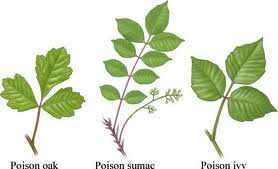Plants really are our friends…for the most part. When it comes to poison ivy, oak and sumac, on the other hand, a better term to use would probably be, “frenemies.”
Each of these plants releases a toxin known as “urushiol,” which causes an itchy, red rash that can last as long as a month. Only a billionth of a gram of urushiol is needed to cause a rash, so it’s best to keep your distance. Whether you’re gardening or taking a hike in the woods this summer, keep and eye out for the following.
Poison Ivy- Perhaps the most well known of the poisonous trio, poison ivy has three pointed leaves with bumpy edges. The middle leaf has a longer stalk than the ones on the sides. Poison ivy grows as a climbing vine.
 Poison Oak- Though it also has three leaves, poison oak can be distinguished from poison ivy because its leaves are lobed (in other words, they have deeply indented margins). Poison oak tends to grow as a shrub, but it can also climb like a vine.
Poison Oak- Though it also has three leaves, poison oak can be distinguished from poison ivy because its leaves are lobed (in other words, they have deeply indented margins). Poison oak tends to grow as a shrub, but it can also climb like a vine.
Poison Sumac– Poison sumac has sharp, compound leaves (or several leaflets attached to the same stalk). It grows as a shrub or small tree in very wet areas and can reach up to 12’ in height.
Long sleeves, long pants, gloves and enclosed footwear can help to protect you from these plants and their toxins. Of course, that isn’t always practical. If you do think you’ve come in contact, you should rinse thoroughly with cold water to remove any traces of urushiol. This toxin can bond with your skin in as little as 15 minutes, so the sooner you can rinse it off, the better.
Fast Fact: Urushiol can stay active on any surface for up to 5 years!


